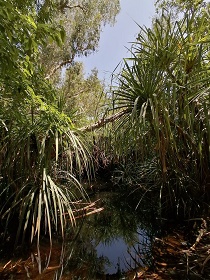Nuptial Gifts in a Cooperative breeder - Australia, Mornington

In the final semester of my MSc degree, I worked with Monash University (Australia) on a research project concerning nuptial gifts in a cooperative breeder.
Nuptial gift giving in general, and courtship feeding in particular, is a behaviour poised between sexual cooperation and sexual conflict: nuptial gifts can act as an indirect paternal investment into shared young between the sexes, or as part of the male’s mating effort trying to ensure access to reproduction. Cooperative breeding, in which more than a pair of conspecifics cooperate to raise young, allows for group living and complex social structures, and thus provides an interesting context in which to study courtship feeding.
In my study, I explored courtship feeding behaviour in the cooperatively breeding bird Malurus coronatus coronatus (purple-crowned fairy wren, Figure 1A). Specifically, I test two research questions. First, how does cooperative breeding affect courtship feeding – is there load-lightening for the dominant male, or increased cumulative investment in terms of courtship feeding for the dominant female? Second, what role does courtship feeding play - does it function as paternal investment or mating effort? I found that dominant male courtship feeding effort was reduced in the presence of subordinates, and dominant females received fewer feeds with increasing subordinate number in some of the datasets. This indicates load-lightening for the dominant male, rather than increased investment in the dominant female, and may represent adaptive undercompensation or a cost of group living. Both reproductive output and copulation rate were not affected by courtship feeding – there is thus no direct evidence for courtship feeding acting as either paternal investment or mating effort.

The fieldwork for this project was carried out at a research station of the AWC (Australian Wildlife Conservancy) in Mornington in North-West Australia. It involved observations of purple-crowned fairy wrens in the wild, in the characteristic riparian habitat for which they are specialized (Figure 1B). Working on this project in general, and the fieldwork in particular, allowed me to gain a better understanding of the various facets and challenges of working on animal behaviour and of collecting data in wild populations. Furthermore, it was an amazing opportunity to experience the fascinating flora, fauna and ecosystems in the Kimberly region in which the field-site was situated.

